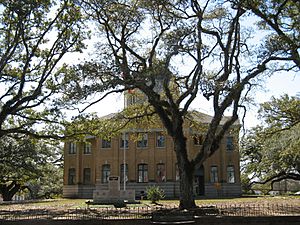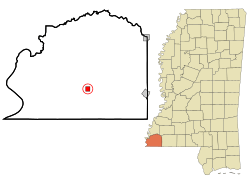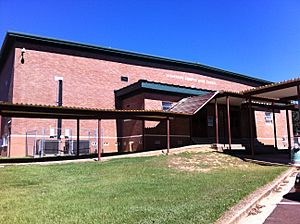Woodville, Mississippi facts for kids
Quick facts for kids
Woodville, Mississippi
|
|
|---|---|

Wilkinson County Courthouse in Woodville
|
|

Location of Woodville, Mississippi
|
|
| Country | United States |
| State | Mississippi |
| County | Wilkinson |
| Area | |
| • Total | 1.04 sq mi (2.68 km2) |
| • Land | 1.04 sq mi (2.68 km2) |
| • Water | 0.00 sq mi (0.00 km2) |
| Elevation | 404 ft (123 m) |
| Population
(2020)
|
|
| • Total | 928 |
| • Density | 895.75/sq mi (345.83/km2) |
| Time zone | UTC-6 (Central (CST)) |
| • Summer (DST) | UTC-5 (CDT) |
| ZIP code |
39669
|
| Area code(s) | 601 |
| FIPS code | 28-81120 |
| GNIS feature ID | 0679870 |
Woodville is a historic town in Mississippi, United States. It is one of the oldest towns in the state. Woodville is also the county seat of Wilkinson County. In 2020, about 928 people lived there.
Contents
Where is Woodville Located?
Woodville is located in the state of Mississippi. The town covers an area of about 1.1 square miles (2.68 square kilometers). All of this area is land, with no large bodies of water inside the town limits.
Who Lives in Woodville?
Woodville's Population Over Time
| Historical population | |||
|---|---|---|---|
| Census | Pop. | %± | |
| 1880 | 965 | — | |
| 1890 | 950 | −1.6% | |
| 1900 | 1,043 | 9.8% | |
| 1910 | 1,233 | 18.2% | |
| 1920 | 1,012 | −17.9% | |
| 1930 | 1,113 | 10.0% | |
| 1940 | 1,433 | 28.8% | |
| 1950 | 1,609 | 12.3% | |
| 1960 | 1,856 | 15.4% | |
| 1970 | 1,734 | −6.6% | |
| 1980 | 1,512 | −12.8% | |
| 1990 | 1,393 | −7.9% | |
| 2000 | 1,192 | −14.4% | |
| 2010 | 1,096 | −8.1% | |
| 2020 | 928 | −15.3% | |
| U.S. Decennial Census | |||
The number of people living in Woodville has changed over many years. The table above shows how the population has grown and shrunk since 1880. In 2020, the town had 928 residents.
Woodville's Diverse Community
| Race | Num. | Perc. |
|---|---|---|
| Black or African American | 677 | 72.95% |
| White | 217 | 23.38% |
| Other/Mixed | 26 | 2.8% |
| Hispanic or Latino | 5 | 0.54% |
| Native American | 2 | 0.22% |
| Asian | 1 | 0.11% |
The 2020 United States census counted 928 people living in Woodville. A census is a count of the population that happens every ten years. This count helps us understand the different groups of people who live in the town.
Most of the people in Woodville are of Black or African American heritage. There are also many White residents. A smaller number of people identify as Native American, Asian, or of mixed heritage. Some residents are also of Hispanic or Latino background.
Education in Woodville
The Wilkinson County School District serves the students in Woodville. There are a few schools close to the town. These include Wilkinson County Elementary School and Wilkinson County High School.
There is also a private school called Wilkinson County Christian Academy. This school was started in 1969. For students who want to continue their education after high school, Wilkinson County is part of the Southwest Mississippi Community College district.
Woodville's Oldest Newspaper
The Woodville Republican is a very old newspaper. It was started in 1823. This makes it the oldest business that is still running in Mississippi. It is also the oldest newspaper in the state.
Famous People from Woodville
Many interesting people have connections to Woodville. Here are a few:
- Julia K. Wetherill Baker (1858–1931) was a writer and poet. She was born in Woodville.
- Betty Bentley Beaumont (1828–1892) was an author and a successful businesswoman.
- Henry Cohen (rabbi) was a rabbi who served in Woodville before becoming a well-known community leader in Texas.
- Jefferson Davis was a leader during the American Civil War. He lived near Woodville as a young boy on his parents' farm and went to Woodville Academy.
- Ronnie Edwards was a politician from Louisiana who was born in Woodville.
- Henry Herbert Ogden was an aviator who flew around the world with the U.S. Army Air Services in 1924.
- Will E. Keller was a businessman.
- Rudolph Matthews was a handball player.
- Edward Grady Partin (1924–1990) was born in Woodville. He became a union leader.
- Carnot Posey was a general during the American Civil War.
- Peter Randolph was a federal judge in the early 1800s.
- Dan Reneau became the President of Louisiana Tech University.
- William Grant Still (1895–1978) was a famous African-American classical composer. He was born in Woodville and is in the Mississippi Musicians Hall of Fame.
- Matt Tolbert is a professional baseball player.
- W. P. S. Ventress (1854–1911) was a state legislator in Mississippi.
- George W. Wheeler was the Chief Justice of the Connecticut Supreme Court.
- Lester Young (1909–1959) was a famous jazz musician. He was born in Woodville and is also in the Mississippi Musicians Hall of Fame.
- William Henry Young was a politician from Wisconsin who was born in Woodville.
See also
 In Spanish: Woodville (Misisipi) para niños
In Spanish: Woodville (Misisipi) para niños



